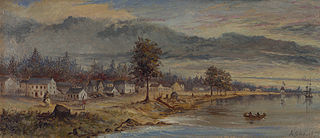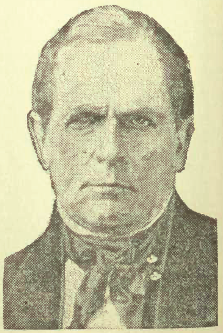
The Province of Upper Canada was a part of British Canada established in 1791 by the Kingdom of Great Britain, to govern the central third of the lands in British North America, formerly part of the Province of Quebec since 1763. Upper Canada included all of modern-day Southern Ontario and all those areas of Northern Ontario in the Pays d'en Haut which had formed part of New France, essentially the watersheds of the Ottawa River or Lakes Huron and Superior, excluding any lands within the watershed of Hudson Bay. The "upper" prefix in the name reflects its geographic position along the Great Lakes, mostly above the headwaters of the Saint Lawrence River, contrasted with Lower Canada to the northeast.

The Clergy Endowments (Canada) Act 1791, commonly known as the Constitutional Act 1791, was an Act of the Parliament of Great Britain which passed under George III. The current short title has been in use since 1896.

York was a town and second capital of the colony of Upper Canada. It is the predecessor to the old city of Toronto (1834–1998). It was established in 1793 by Lieutenant-Governor John Graves Simcoe as a "temporary" location for the capital of Upper Canada, while he made plans to build a capital near today's London, Ontario. Simcoe renamed the location York after Prince Frederick, Duke of York and Albany, George III's second son. Simcoe gave up his plan to build a capital at London, and York became the permanent capital of Upper Canada on February 1, 1796. That year Simcoe returned to Britain and was temporarily replaced by Peter Russell.

The Family Compact was a small closed group of men who exercised most of the political, economic and judicial power in Upper Canada from the 1810s to the 1840s. It was the Upper Canadian equivalent of the Château Clique in Lower Canada. It was noted for its conservatism and opposition to democracy.

This section of the Timeline of Quebec history concerns the events in British North America relating to what is the present day province of Quebec, Canada between the time of the Constitutional Act of 1791 and the Act of Union 1840.
Christopher Alexander Hagerman, was a Canadian militia officer, lawyer, administrator, politician and judge.

Sir John Beverley Robinson, 1st Baronet, was a lawyer, judge and political figure in Upper Canada. He was considered the leader of the Family Compact, a group of families which effectively controlled the early government of Upper Canada.
The 9th Parliament of Upper Canada was opened 11 January 1825. Elections in Upper Canada had been held in July 1824. All sessions were held at York, Upper Canada. This parliament was dissolved 24 June 1828.

Thomas David Morrison was a doctor and political figure in Upper Canada. He was born in Quebec City around 1796 and worked as a clerk in the medical department of the British Army during the War of 1812. He studied medicine in the United States and returned to York in 1824 to become a doctor in Upper Canada. He treated patients and served on the Toronto Board of Health during the 1832 and 1834 cholera outbreaks and co-founded the York Dispensary. In 1834 he was elected to the 12th Parliament of Upper Canada, representing the third riding of York County as part of the reform movement. That same year he was elected as an alderman to the Toronto City Council and reelected the subsequent two years. In 1836, he served a term as mayor of Toronto.

The Legislative Council of Upper Canada was the upper house governing the province of Upper Canada. Modelled after the British House of Lords, it was created by the Constitutional Act of 1791. It was specified that the council should consist of at least seven members. Members were appointed for life but could be dropped for non-attendance. The first nine members of the council were appointed on 12 July 1792. The speaker was usually the Chief Justice of the Court of King's Bench. The Legislative Council was dissolved on 10 February 1841 when Upper and Lower Canada were united into the Province of Canada. Some members were reappointed to the Legislative Council of the united Province.
The Legislative Council of Lower Canada was the upper house of the bicameral structure of provincial government in Lower Canada until 1838. The upper house consisted of appointed councillors who voted on bills passed up by the Legislative Assembly of Lower Canada. The legislative council was created by the Constitutional Act. Many of the members first called in the Council in 1792 had served as councillors in the Council for the Affairs of the Province of Quebec.
Thomas Parke was an architect, builder, journalist and political figure in Upper Canada.
Amable Berthelot was a Canadien lawyer, author and political figure. He was elected to the Legislative Assembly of Lower Canada and later to the Legislative Assembly of the Province of Canada. Trained as a lawyer, he was an avid book-collector, at one point having a personal library of some fifteen hundred volumes. He did not support those who took up arms during the Lower Canada Rebellion of 1837–1838. He never married, but adopted two children, a boy and a girl. His daughter married Louis-Hippolyte LaFontaine, later co-premier of the Province of Canada. He was a literary mentor to François-Xavier Garneau.

Joseph-Rémi Vallières de Saint-Réal was a lawyer, judge and political figure in Lower Canada.
John Robinson Hamilton, QC was a lawyer and political figure in Lower Canada and then the Province of Canada. He represented the electoral district of Bonaventure 1832 to 1834 in the Legislative Assembly of Lower Canada. Following the creation of the Province of Canada, he again represented Bonaventure from 1841 to 1844 in the Legislative Assembly of the Province of Canada. He opposed the union of Lower Canada and Upper Canada into the Province of Canada, and supported the reform movement, which favoured responsible government.

The Parliament of Upper Canada was the legislature for Upper Canada. It was created when the old Province of Quebec was split into Upper Canada and Lower Canada by the Constitutional Act of 1791.

The cultural and legal framework within which tradesmen contracted for work, and hired men was similar to that of Great Britain. These immigrants quickly sought to establish and regulate the basic institutions of the trades: Friendly societies, the house of call and apprenticeship. Friendly societies were worker controlled mutual insurance organizations. They provided an income in the case of strike, injury or economic downturn. Their association with specific trades also made them useful vehicles for trade union organization.

After the American Revolutionary War, U.S. printers were freed of British copyright restrictions and freely reprinted British works. Upper Canadian printers remained bound by British copyright. American presses quickly took the lead in producing cheap editions and eventually the printing of original work.
Kent was an electoral district of the Legislative Assembly of the Parliament of the Province of Canada, in Canada West. It was created in 1841, upon the establishment of the Province of Canada by the union of Upper Canada and Lower Canada. Kent was represented by one member in the Legislative Assembly. It was abolished in 1867, upon the creation of Canada and the province of Ontario.















